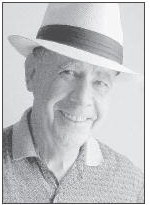The Butter Mold


She's still full of questions.
“Little Miss Phillips” was fingering a round wooden object that looked like a bowl with a plunger in the middle. She turned it over and tried to reason it out before asking, “What’s this?”
“What does it look like?” I responded, sounding like the Baron of Bear Creek who answers questions with a question.
“It looks like something to do with modeling clay because you could pack it full and push it out.” “Yes, but that belonged to your great- great- grandmother, and she didn’t play with clay.” She turned it over and finally looked up grinning, “butter mold.” This butter mold was probably machine turned out of poplar and served our Phillips family well. It’s a quarter pound mold with the design of acorns on the plunger, which were impressed into the mound of butter.
My grandmother used this to mold butter for household use.
LMP pulled out two more molds. Both are rectangular in shape but of different sizes. These are the molds my grandmother used for butter she sold; they are for half-pound and one-pound blocks of butter.
My grandmother Lois Milam Phillips was fifteen years old when she married in 1892 and used the butter molds.
In those days there were two “peddlers” who visited families in our community buying eggs and butter then taking those items to sell to Atlanta housewives.
Mr. Ed Wood lived across the river in the Boyd Settlement and traveled the countryside in a wagon before he bought a truck. The other peddler was a Mr. High, whose family would become prosperous and build the High Museum in Atlanta.
Atlanta was an all-day trip in those days. Before a state farmer’s market was created, rural people set up in Mr. Souder’s wagon yard near downtown Atlanta. They left their rig and belongings guarded by a family dog while they attended to whatever business required the trip. Mr. Wood was accommodat ing about special orders. My grandmother ordered a treadle sewing machine, which Mr. Wood picked up and delivered to her in his wagon. I’d love to have it.
The treadle-sewing machine, along with many other family items were stolen and sold out of a truck in the employee parking lot at Lockheed. The thieves took more than “things” from the house. They took connections to the history of the county, pictures, letters, journals.
Justice ground slowly, sputtered and continued from page
died. We are fresh out of milk cows, and the milk sold today is processed beyond producing butter. We found cream in the refrigerator and whipped it until flecks of butter appeared. This showed we could make butter. My Phillips relatives owned Guernsey and Jersey cows. They produce milk high in butter fat.
As a kid I helped milk cows and bring milk inside to sit behind the stove until it clabbered, then it was churned slowly until the butterfat rose to the top. The butter was skimmed off, and the whey flowed out of it as it was pressed into the mold. The milk left in the churn was buttermilk. Pouring fresh, cool spring water over the butter helped it harden.
Our experiment continued with a trip for store-bought butter. After the butter softened, I told her the story of the butter molds, along with the family connections, while she packed the smallest mold with butter.
Tomorrow morning the Kansas Woman will bake buttermilk biscuits for breakfast, and the mound of butter with acorns pressed into the top will sit on a dish Grandmother Phillips used for the same purpose.
“Let’s go to the High Museum,” LMP offered.
Since we aren’t doing anything special, we might as well.
joenphillips@yahoo.com









